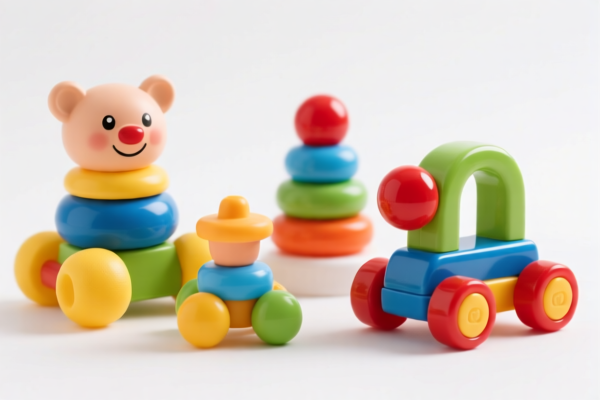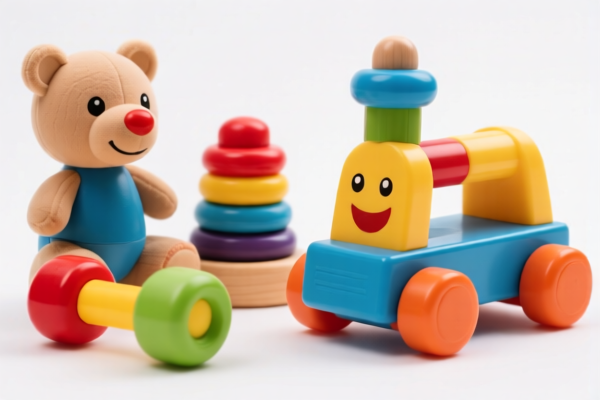| HS Code | Official Doc | Tariff Rate | Origin | Destination | Effective Date |
|---|---|---|---|---|---|
| 9503000071 | Doc | 30.0% | CN | US | 2025-05-12 |
| 9503000090 | Doc | 30.0% | CN | US | 2025-05-12 |
| 3924900500 | Doc | 40.6% | CN | US | 2025-05-12 |
| 3926901600 | Doc | 40.6% | CN | US | 2025-05-12 |
| 3926909910 | Doc | 42.8% | CN | US | 2025-05-12 |
| 6307907500 | Doc | 34.3% | CN | US | 2025-05-12 |
| 6304996040 | Doc | 33.2% | CN | US | 2025-05-12 |
| 6304996030 | Doc | 33.2% | CN | US | 2025-05-12 |
| 9601906000 | Doc | 37.5% | CN | US | 2025-05-12 |
| 9601908000 | Doc | 41.2% | CN | US | 2025-05-12 |
| 9602001040 | Doc | 40.5% | CN | US | 2025-05-12 |
| 9602005080 | Doc | 40.2% | CN | US | 2025-05-12 |
| 3503005550 | Doc | 2.8¢/kg + 3.8%+37.5% | CN | US | 2025-05-12 |




Teething Toys
Teething toys are objects designed for infants to chew on during the teething process. They provide relief from the discomfort associated with erupting teeth.
Material
Teething toys are manufactured from a variety of materials, each with its own characteristics:
- Silicone: A non-toxic, rubber-like material that is durable, easy to clean, and generally considered safe for babies to mouth. Food-grade silicone is the preferred type.
- Rubber: Natural rubber (latex) is another common material, offering a softer texture. However, latex allergies are a concern for some infants.
- Wood: Often maple wood, it is naturally antibacterial and provides a firm surface for chewing. Toys are typically finished with food-safe waxes or oils.
- Plastic: Historically used, plastic teething toys are now less common due to concerns about BPA, phthalates, and other potentially harmful chemicals. If used, toys should be BPA-free, phthalate-free, and PVC-free.
- Fabric: Cloth teething toys, often filled with soft materials, are suitable for gentle chewing and provide a different texture.
Purpose
The primary purpose of teething toys is to alleviate the pain and discomfort caused by teeth breaking through the gums. They also:
- Provide Sensory Stimulation: Different textures and shapes offer sensory input for developing babies.
- Encourage Exploration: Teething toys allow babies to explore their environment through mouthing and chewing.
- Promote Oral Development: Chewing helps strengthen jaw muscles and prepare for solid foods.
Function
Teething toys function by:
- Counter-Pressure: The pressure applied by chewing can soothe inflamed gums.
- Gum Massage: The texture of the toy can massage the gums, reducing swelling and pain.
- Distraction: Providing a safe object to chew on can distract the baby from discomfort.
- Cooling: Some toys are designed to be chilled, providing a cooling sensation that numbs the gums.
Usage Scenarios
Teething toys are typically used when a baby exhibits signs of teething, including:
- Increased Drooling: Excessive saliva production is common during teething.
- Gum Swelling and Tenderness: Gums may appear red and inflamed.
- Irritability and Fussiness: Teething can cause discomfort and lead to increased irritability.
- Chewing on Hands and Objects: Babies instinctively chew on anything they can reach to relieve gum pressure.
- Refusal to Eat: Sore gums can make eating uncomfortable.
Teething toys can be used under supervision, and should be cleaned regularly to prevent bacterial growth.
Common Types
- Teething Rings: Classic circular toys, often with textured surfaces.
- Teething Rattles: Combine chewing relief with auditory stimulation.
- Teething Mittens: Worn on the baby’s hand, allowing them to chew on their own hand.
- Teething Necklaces: Worn by the caregiver, allowing the baby to chew on a safe pendant. (Supervision required)
- Wooden Teethers: Offer a firm, natural chewing surface.
- Water-Filled Teethers: Can be chilled in the refrigerator for cooling relief.
- Brush Teethers: Designed to mimic a toothbrush and prepare the baby for oral hygiene.
- Fruit Feeders: Allow babies to safely chew on soft fruits. (Supervision required)
Teething toys are generally considered toys designed for infants to chew on during the teething process, providing relief from gum discomfort. They can be made from various materials like plastic, rubber, wood, or gel-filled components.
Here are relevant HS codes based on the provided reference material:
- 9503000071: This HS code covers Tricycles, scooters, pedal cars and similar wheeled toys; dollsʼ carriages; dolls, other toys; reduced-scale (“scaleˮ) models and similar recreational models, working or not; puzzles of all kinds; parts and accessories thereof “Childrenʼs productsˮ as defined in 15 U.S.C. § 2052: Other: Labeled or determined by importer as intended for use by persons: Under 3 years of age. This code applies if the teething toy is classified as a general toy for children under 3 years old. The total tax rate is 30.0%.
- 9503000090: This HS code covers Tricycles, scooters, pedal cars and similar wheeled toys; dollsʼ carriages; dolls, other toys; reduced-scale (“scaleˮ) models and similar recreational models, working or not; puzzles of all kinds; parts and accessories thereof Other. This code applies if the teething toy is classified as a general toy, without specific age labeling. The total tax rate is 30.0%.
Important Note: Both HS codes 9503000071 and 9503000090 are categorized under "Children’s products" as defined in 15 U.S.C. § 2052. Importers should ensure compliance with all relevant safety standards and labeling requirements for children’s products.
Customer Reviews
No reviews yet.